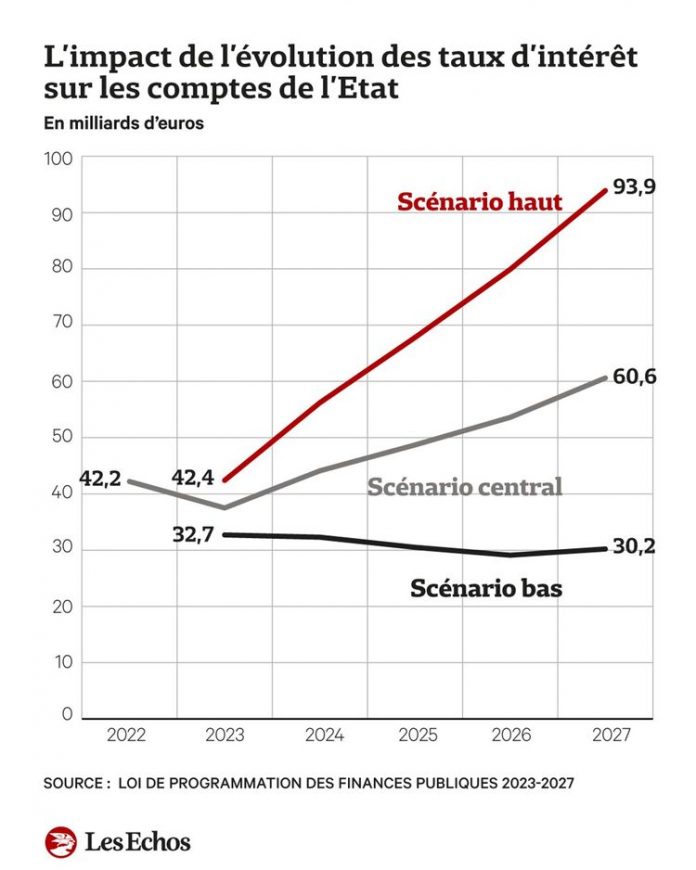Posted Sep 29, 2022, 6:00 AMUpdated on Sep 29, 2022 at 7:09 am
When he alerted at the end of the summer to “the end of abundance”, Emmanuel Macron took care to specify that this applied to raw materials as well as to “cash without cost”. In fact, the trajectory of public finances unveiled on Monday by the executive acts well “the end of recklessness” also announced by the Head of State: the cost of debt should increase by nearly 20 billion euros during the five-year period, according to the central scenario of Bercy, to reach a level almost three times higher than that recorded in 2020.
In fact, France is preparing to emerge from the era opened by Mario Draghi’s “whatever it takes” in 2012, when the then head of the ECB opened the floodgates of liquidity to save the euro zone. France’s borrowing rates had fallen, and the cost of debt with them, even though indebtedness continued to rise: the interest charge had thus fallen from 44.5 billion in 2011 to 23 billion in 2020 (in Maastrichian accounting, the one that counts for European rules).
Easy budgetary savings, which greatly facilitated the life of the governments of François Hollande and then Emmanuel Macron.
The shock of inflation
But times are changing. Already in 2022, the bill should rise sharply, by more than 17 billion euros, to 42.2 billion. Admittedly, the debt grew during the health crisis (111.5% of GDP this year, compared to less than 100% before the Covid) but it is above all inflation – part of French bonds are indexed to the evolution of price – which explains this movement. Next year, the expected slowdown in inflation should lead to a slight lull, and bring down the interest charge to 37.5 billion.
But this is only a short respite. Bercy anticipates an end to “magic money” and a gradual increase in the rates at which France finances itself at 10 years. In the public finance programming law unveiled at the start of the week, these are expected to be 2.50% at the end of 2022 then 2.60% at the end of 2023 before converging towards 3% by 2027.
This scenario could heavily increase the cost of the debt: it would therefore rise from 42.2 billion in 2022 to 60.6 billion in 2027. A difference of nearly 20 billion – 18.4 billion very precisely – i.e. almost the budget of the Ministry of Ecology this year (20.6 billion).
“It could be a little underestimated and stronger in reality if the rise in rates was more significant”, warned Pierre Moscovici, first president of the Court of Auditors, before the Finance Committee of the Assembly this Wednesday . “This makes it all the more important to lower our debt ratio,” added the man who is also president of the High Council of Public Finances.
Soaring bill
In its assumptions, Bercy thus calculates that higher rates of 1 point would lead to an additional increase of 17 billion in the interest charge. With rates higher by 2 points – we would then be at nearly 5%, the level at the start of the century – the bill would even rise to a total of 93.9 billion! Conversely, lower rates would have opposite effects in the same proportions.
During his hearing, Pierre Moscovici took care to specify that “the French debt remains sustainable and financeable”. In fact, the interest charge should only represent 2.1% of GDP in 2027, compared to 1.8% in 2022. A reasonable level, which no doubt explains why France continues to invest large amounts without too many problems debt on the markets – another 270 billion next year, a record . “We have the confidence of investors, we see it in our fundraising”, argued Wednesday Gabriel Attal, the Minister Delegate of Public Accounts, on BFM Business.
But the markets are becoming nervous again, and the borrowing rates of European states have started rising sharply in recent days. Great Britain has, from this point of view, become the example of what not to do, the massive public deficit assumed by Liz Truss at the end of last week having caused a surge in its rate. This is why the Governor of the Banque de France, François Villeroy de Galhau, called on Tuesday to “stay the course of a French budgetary policy anchored on a standard of expenditure actually held”.
A stone in the garden of the government, which provides for a high level of public deficit, at 5% of GDP next year.














